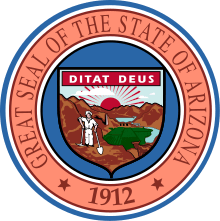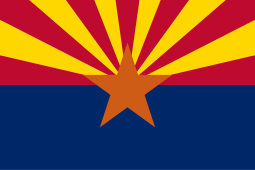Jane Dee Hull
| Jane Hull | |
|---|---|
 | |
| 20th Governor of Arizona | |
|
In office September 5, 1997 – January 6, 2003 | |
| Preceded by | Fife Symington |
| Succeeded by | Janet Napolitano |
| 16th Secretary of State of Arizona | |
|
In office January 2, 1995 – September 5, 1997 | |
| Governor | Fife Symington |
| Preceded by | Richard Mahoney |
| Succeeded by | Betsey Bayless |
| Member of the Arizona House of Representatives | |
|
In office 1979-1993 | |
| Personal details | |
| Born |
Jane Dee Bowersock August 8, 1935 Kansas City, Missouri, U.S. |
| Political party | Republican |
| Spouse(s) | Terry Hull |
| Children | 4 |
| Alma mater |
University of Kansas, Lawrence Arizona State University |
| Religion | Roman Catholicism |
| [1][2][3] | |
Jane Dee Hull (née Bowersock; born August 8, 1935) is an American politician who served as the 20th Governor of Arizona from 1997 to 2003. She was the second woman to serve as Governor of Arizona and the first female Republican governor of the state.
Biography
Born Jane Dee Bowersock in Kansas City, Missouri, Hull graduated from the University of Kansas with a degree in education. She taught elementary school in Kansas and, while her husband was a public health physician there, in Navajo Nation schools at Chinle, Arizona.
She moved to Arizona in 1962, after hearing a Barry Goldwater speech.[1] She campaigned for Goldwater in the United States presidential election in 1964.[4]
Hull entered politics in 1978 by being elected to the Arizona House of Representatives as a Republican. She served for seven terms, including two as Speaker of the House, the first female Speaker in Arizona history.
In 1991, while she was Speaker, the Arizona legislature experienced a major political scandal called AZSCAM, which resulted in the resignation or removal of ten members of the House and Senate. As a result, Speaker Hull instituted a number of ethics reforms to reestablish public confidence in the legislature.
Hull was elected Arizona Secretary of State in 1994. After Governor Fife Symington was forced to resign due to a felony conviction, Hull became governor on September 5, 1997.[5] She was sworn in by U.S. Supreme Court Justice Sandra Day O'Connor, herself a former Arizona legislator. Arizona has no lieutenant governor, so the secretary of state, if holding office by election,[6] stands first in the line of succession.
Hull was elected governor in her own right in 1998. This election was particularly significant because it was the first time in the history of the United States that all five of the top elected executive offices in one state were held by women: Hull; Betsey Bayless, secretary of state; Janet Napolitano, attorney general; Carol Springer, treasurer; and Lisa Graham Keegan, Superintendent of Public Instruction. Hull was constitutionally barred from running for a second full term in 2002 (the Arizona constitution limits the Governor to two consecutive terms, or parts of terms,[7] even when he or she ascends to the office in the middle of a term), and she was succeeded by Janet Napolitano, who defeated Matt Salmon.
While she was governor, Hull's relations with home state U.S. Senator John McCain were strained. During the 2000 primary season she endorsed his opponent, Texas Governor George W. Bush, in the Arizona primary.[8]
After leaving office, she spent three months in New York City, as a public delegate from the United States to the United Nations General Assembly (2004).[9]
After the death of Rose Mofford on September 15, 2016, Hull became the oldest living Governor of Arizona, in addition to being the oldest living Secretary of State of Arizona.
Legacy
An elementary school is named for Hull in Chandler, Arizona.
Hull is known for signing the bill that resulted in the "alt-fuels" scandal of 2000. The resulting law promised car buyers up to 60 percent off new vehicles if they were converted to run on alternative fuels like propane or natural gas, yet did not properly cap the number of buyers eligible for the program, (nor did it force buyers to use the new fuels). Instead of the $10 million the program was supposed to cost, it ended up costing Arizona $200 million before lawmakers changed the rules.
Hull is also known in her role as governor for signing the death warrants
[10] of two foreign nationals, despite international pressure from Germany for a stay of execution in the LaGrand Case.[11]
Electoral history
| Party | Candidate | Votes | % | ± | |
|---|---|---|---|---|---|
| Republican | Jane Dee Hull (incumbent) | 620,188 | 60.95 | ||
| Democratic | Paul Johnson | 361,552 | 35.53 | ||
| Libertarian | Katherine Gallant | 27,150 | 2.67 | ||
See also
References
- 1 2 Purdum, Todd S. (September 5, 1997). "Once Again in Arizona, Secretary of State Is Suddenly Thrust Into the Job of Governor". New York Times. Retrieved 2009-04-20.
- ↑ "Governor's Information – Arizona Governor Jane Dee Hull". National Governors Association. Retrieved 2009-04-20.
- ↑ "GOVERNOR Jane Dee Hull". Arizona Blue Book – Chapter 3. Secretary of State of Arizona. Archived from the original on 2003-12-02. Retrieved 2009-04-20.
Jane Dee Hull was born August 8, 1935, in Kansas City, Missouri. She received her Bachelor's degree in Elementary Education from the University of Kansas in 1957 and has taken postgraduate courses in political science and economics at Arizona State University. She is also a graduate of the Josephson Ethics Institute. She taught in the Chinle, Arizona, schools from 1962–1964. Mrs. Hull was elected to the Arizona House of Representatives in 1978, taking office in January 1979. She represented District 18 until resigning her position in 1993 to run for Secretary of State. During her tenure in the House of Representatives, she served as Chairman of the Government Operations Committee and in 1988 was elected Majority Whip. She served two terms as the Speaker of the House (1989–1992), the first woman to do so. Her final year in the Legislature, Mrs. Hull served as Speaker Pro Tem and as Chairman of the Economic Development Committee and the Ethics Committee. The National Republican Legislators Association named Mrs. Hull National Legislator of the Year in 1989. Mrs. Hull was elected Arizona's 16th Secretary of State in 1994 and took office in January 1995, the first Republican to be elected to the office since 1931. She became Arizona's 20th governor September 5, 1997, upon the resignation of J. Fife Symington. She serves on the boards of numerous community, service, and political organizations. She and her husband Terry, a semi-retired obstetrician, have four children and eight grandchildren. Governor Hull took office in 1997 with a pledge to provide stability, integrity, and trusted leadership to the people of Arizona. Throughout her distinguished and ground-breaking career in public service, she has done just that. As governor, she has made education, children, preserving Arizona's natural beauty, and the economy her top priorities. In her first years in office, she has delivered on every one of these issues, with record investments in our schools, a program to provide health insurance to the children of the working poor, her Growing Smarter plan to address growth across the state, and targeted tax cuts to continue Arizona's record growth. Governor Hull will continue to provide responsible leadership that is working to lead Arizona proudly into the next century.
- ↑ Hull, Jane Dee. "The Challenge of Public Service". The Power of Character. Los Angeles, California: Josephson Institute Center for Public Service Ethics. Retrieved 2009-04-21.
My love for politics took hold when I was campaigning for Barry Goldwater in the 1964 presidential election. Since then I’ve been hooked on the prospect of having a say in the policies that affect the everyday lives of my family, friends, and the citizens of Arizona. After years as a precinct committeewoman getting out the vote, I won a seat to the Arizona House of Representatives in 1978. Eight years later I was elected Republican Whip, the first woman to ever become part of the majority leadership in Arizona. In 1989 my colleagues elected me Speaker of the House. After three years as Speaker, I served as chairwoman of the Ethics Committee until I resigned from the House to run for secretary of state. I was elected. In an unexpected turn of events, I became governor when the previous governor resigned due to several federal convictions.
- ↑ Purdum, Todd S. (September 4, 1997). "Arizona Governor Convicted Of Fraud and Will Step Down". New York Times.
- ↑ Ariz. Const. art. V, s. 6
- ↑ Ariz. Const. Art. V, § 1(a).
- ↑ Berke, Richard L. (October 25, 1999). "McCain Having to Prove Himself Even in Arizona". New York Times. Retrieved 2009-04-21.
- ↑ KAET-TV (September 23, 2007). "Former Governor Jane Dee Hull – Twenty-Five Years in Arizona Government". 2006 Goldwater Lecture Series. Phoenix, Arizona: Arizona State University. Retrieved 2009-04-20.
- ↑ In Arizona, the Governor does not issue death warrants. Death warrants are issued by the Supreme Court of Arizona. Ariz. Rev. Stat. § 13-759(A)
- ↑ Michael Fleishman (2004-03-24). "RECIPROCITY UNMASKED: THE ROLE OF THE MEXICAN GOVERNMENT IN DEFENSE OF ITS FOREIGN NATIONALS IN UNITED STATES DEATH PENALTY CASES" (PDF). Arizona Journal of International and Comparative Law. Tucson, Arizona: University of Arizona James E. Rogers College of Law. 20 (2): 389–391. Retrieved 2009-04-20.
Despite a binding Provisional Measures Order from the ICJ and a recommendation of the Arizona Clemency Board to stay LaGrand’s execution, Arizona Governor Jane Dee Hull refused the stay. On the night of March 3, 1999, Walter LaGrand became the last person in Arizona to be executed by lethal gas. The German press, from across the political spectrum, lobbed vitriolic commentary towards the United States and the State of Arizona. The conservative daily Die Welt said of Arizona Governor Jane Dee Hull, she is “[a] tough state governor [who] enforces a medieval sentence, proud of her convictions; regardless of [the] obvious procedural shortcomings and modern, international law.” The State of Arizona followed the path of Virginia in the Breard case, giving short shrift to international law and placing the United States in the position of once again defending the actions of individual states. On June 27, 2001, the International Court of Justice issued its binding merits decision in the LaGrand case, the details of which are discussed infra.
External links
- Biography of Jane Dee Hull from the United States Mission to the United Nations
- Governor Jane Dee Hull (Jeff Scott's biography)
- Alt-Fuels Fiasco (Synopsis by Arizona Republic)
- Hull, Jane Dee (2004). "Governor Jane Dee Hull". In Michael S. Josephson and Wes Hanson. The Power of Character. Unlimited Publishing LLC,. pp. 242–249. ISBN 978-1-58832-106-0. Retrieved 2009-04-20.
| Political offices | ||
|---|---|---|
| Preceded by Richard Mahoney |
Secretary of State of Arizona 1995–1997 |
Succeeded by Betsey Bayless |
| Preceded by Fife Symington |
Governor of Arizona 1997–2003 |
Succeeded by Janet Napolitano |
| Party political offices | ||
| Preceded by Fife Symington |
Republican nominee for Governor of Arizona 1998 |
Succeeded by Matt Salmon |

